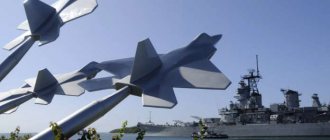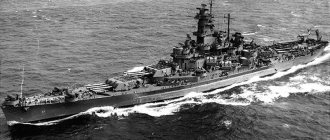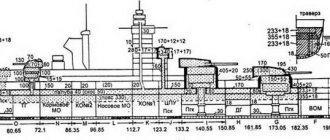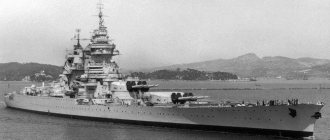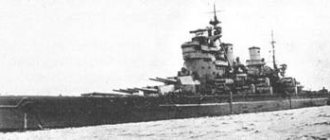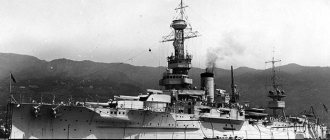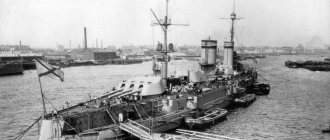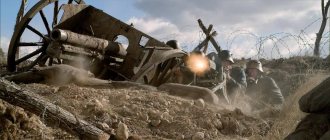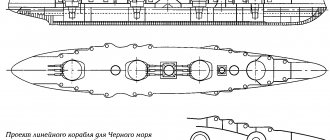Fast battleship
The Iowas were the pinnacle of American battleship construction, at least if we take the projects embodied in metal.
These ships made a kind of breakthrough, strikingly distinguishing them from any analogues. This breakthrough was not the armor, although it was very, very good. The main caliber artillery did not become one either - yes, these were the best guns that were installed on American battleships, but the Japanese Yamato and Musashi were more serious in this regard.
This breakthrough was speed - 32.4 knots without boost. It was extremely serious. The most modern American battleships after the Iowas, the South Dakota, were limited to 27.5 knots - just like the Japanese Yamato.
The outcome of the war in the Pacific was decided not by battleships, but by aircraft carriers. Large artillery ships provided stability to aircraft carrier formations and bombarded the coasts during landings. And then it turned out that the Americans hit the top ten. The speed of the Iowas turned out to be many times more important than the security and ability of 406-mm shells fired from a 50-caliber barrel to penetrate enemy armor. The new battleships could, most importantly, move as part of aircraft carrier groups without reducing their overall speed. Which was extremely important in the vast expanses of the Pacific Ocean.
Construction and armor
The maximum length of the vessel was 270 meters. The design displacement exceeded 48,000 long tons, the maximum was in the range of 55-57.5 thousand tons. Four turbo-gear units produced power equal to 212,000 horsepower. The maximum speed was 32.5 knots. Much attention was paid to the cruising range - the Iowa could travel autonomously over a distance of up to 15,000 nautical miles. During the Second World War, the crew included 2,800 people; in the mid-80s, it decreased to 1,800 sailors and officers.
The ship's armor was similar to that of the previous series of South Dakota class battleships. The main belt was sheathed with 307 mm cemented steel, which withstood shells fired from 406 mm naval guns. The main caliber towers, barbettes and conning tower were protected by metal plates with a thickness of 184 to 440 mm.
Mine protection ensured the survivability of the ship when it was torpedoed by 317 kg TNT shells. These were quite high figures, but the Japanese 610-mm torpedoes carried a charge corresponding to 490 kg of explosive. In 1943, Japanese battleships began to have even more powerful underwater weapons. The meeting of two sea giants on the high seas could be tragic for an American.
World War II
Added to the central role of aircraft carriers was the undivided industrial dominance of the United States, which began to take its toll just when four Iowa-class battleships entered the Pacific theater of operations.
In this sense, the first battle of the new battleships, which took place on February 17, 1944 near the island of Truk, is indicative. Iowa and her sister ship New Jersey, supported by cruisers and destroyers, fought their first naval battle with enemy ships. It was, in essence, a beating of a small detachment of Japanese. The Americans destroyed a training cruiser, an armed trawler and a destroyer (another destroyer managed to escape).
"Iowa" in the Pacific Ocean
But it is even more significant that this was not only the first, but also the last collision of the Iowas with enemy ships. But the new battleships often had to shell the coast. The Americans even created a high-explosive fragmentation projectile that weighed less than an armor-piercing one - all in order to reduce the wear of barrels when working on the ground.
Another important role of the Iowas was the fight against aircraft, and especially kamikazes. Powerful anti-aircraft artillery helped a lot with this. It grew so much during the war that, thanks in no small part to it, the number of crew increased by 700-800 people from the design one. And on "Missouri" and for a good thousand.
The same "Missouri", by the way, is inextricably linked with the end of World War II - it was on its deck that the surrender of Japan was signed on September 2, 1945.
American Iowa-class battleships
Many experts call Iowa-class battleships the most advanced ships created in the era of armor and artillery. American designers and engineers managed to achieve a harmonious combination of the main combat characteristics - speed, protection and weapons.
The design of these airliners began in 1938. Their main purpose is to accompany high-speed aircraft carrier formations and protect them from Japanese battle cruisers and heavy cruisers. Therefore, the main condition was a 30-knot speed. At this time, the restrictions of the London Naval Conference of 1936 ended due to Japan's refusal to sign the final document. During the work, the standard displacement increased from 35 to 45 thousand tons, and the artillery received a caliber of 406 mm instead of 356 mm. This made it possible to develop a ship whose protection and armament were superior to those already built on ships of this type, using the increase in displacement to install more powerful machines. In the new project, almost 70 meters were added to the length of the hull, the width remained unchanged, it was limited by the width of the Panama Canal. The hull was also lightened due to the new location of the power plant, which made it possible to narrow the stern and bow of the ship. In particular, because of this, American battleships acquired a characteristic “bludgeon” appearance.
The increased length of the hull affected the weight of the armor, although, in fact, the thickness of its elements remained the same as on ships of the South Dakota class - the main armor protection belt was 310 mm.
The Iowa-class ships received new 406-mm guns, the barrel length of which was the same as on the 50-caliber guns. The new Mk-7 guns were superior in power to their predecessors - the 406-mm 45-caliber Mk-6, which were equipped with ships of the South Dakota type. And in comparison with the 406-mm Mk-2 and Mk-3 guns developed in 1918, the new Mk-7 has significantly reduced weight, and the design has been modernized.
It is worth noting that this artillery system has quite an interesting history. In the 1920s, a large number of 406 mm/50 guns were produced, which were equipped with battlecruisers and battleships, which later became victims of the Washington Conference. The use of these guns in the new project significantly reduced financial costs, and also justified the increase in displacement by installing new, more powerful weapons. But as a result, it turned out that it would be necessary to increase the displacement by at least another 2000 tons. The engineers found a way out - they re-made lighter guns, fortunately there was enough design groundwork. For guns of the Mk-7 type, the barrel was attached to a liner, which reached a diameter of 1245 mm in the area of the charging chamber, and 597 mm at the muzzle. The number of rifling was 96, they reached a depth of 3.8 mm with a rifling steepness of one turn for every 25 calibers. Chrome plating of the barrel bore was also used at a distance of 17.526 meters from the muzzle with a thickness of 0.013 mm. The survivability of the barrel was approximately 300 shots. In this case, the piston bolt at the swinging barrel was tilted down. Structurally, it had 15 stepped sectors, and the rotation angle reached 24 degrees. After the shot, the barrel bore was purged with low pressure air.
The weight of the gun reached 108 tons without an installed bolt and 121 tons with it. When firing, a powder charge weighing almost 300 kilograms was used, which could throw an armor-piercing 1225-kilogram projectile over 38 kilometers. In addition, the gun could fire high-explosive fragmentation shells. As part of the project, the Iowa's ammunition was supposed to include 1016-kilogram Mk-5 armor-piercing shells, but in mid-1939 the US Navy received a new MK-8 shell, the weight of which reached 1225 kilograms. This is the heaviest projectile of this caliber, which became the basis of the firepower of all American battleships, starting with North Carolina. As a comparison, the 406 mm projectile used on the English battleship Nelson weighed only 929 kg, and the 410 mm projectile from the Japanese Nagato weighed 1020 kg. Approximately 1.5% of the weight of the Mk-8 projectile was the explosive charge. When hitting armor with a thickness of more than 37 mm, the Mk-21 bottom fuse was cocked, which was triggered with a delay of 0.033 seconds. With a full powder charge, an initial velocity of 762 m/s was provided; when it was reduced, this figure dropped to 701 m/s, which provided ballistics similar to that of the projectiles of the 45-caliber Mk-6 guns.
True, such power also had a downside - severe wear on the barrel. Therefore, when the battleships needed to bombard the shore, a lighter projectile was developed. The high-explosive Mk-13, adopted for service in 1942, weighed only 862 kilograms. It was equipped with several different fuses: Mk-29 - instant impact, Mk-48 - impact with a delay of 0.15 seconds, as well as a Mk-62 remote tube with a time setting of up to 45 seconds. 8.1% of the weight of the projectile was occupied by explosives. Towards the end of the war, when the main caliber of battleships was used only for shelling the shore, Mk-13 shells received charges reduced to 147.4 kilograms, which provided an initial speed of 580 m/s.
In the post-war years, the ammunition load of Iowa-class battleships was replenished with several new types of 406-mm shells. In particular, based on the body of the Mk-13 landmine, the Mk-143, 144, 145 and 145 were developed. All of them used electronic remote tubes of various types. In addition, Mk-144 and 146 had 400 and 666 explosive grenades, respectively.
In the early 1950s, the Mk-7 guns received the Mk-23 projectile, which was equipped with a W-23 nuclear charge - 1 kt of TNT. The weight of the projectile was 862 kilograms, the length was 1.63 meters, and the appearance was almost completely identical to the Mk-13. According to official data, nuclear artillery shells were in service with the battleships Iowa from 1956 to 1961, but in fact they were stored ashore the entire time.
And already in the 1980s, the Americans tried to develop a high-range sub-caliber projectile for 406 mm guns. Its weight was supposed to be 454 kilograms, and the initial speed was 1098 m/s with a maximum flight range of 64 kilometers. True, this development never left the experimental testing stage.
The rate of fire of the guns was two rounds per minute, and independent fire was ensured for each gun in the turret. Of her contemporaries, only the Japanese superbattleships Yamato had a heavier main gun salvo weight. The total weight of the turret with three guns was approximately 3 thousand tons. The shooting was carried out by a crew of 94 personnel.
The tower made it possible to aim 300 degrees horizontally and +45 and -5 degrees vertically. 406-mm shells were stored vertically in a fixed ring magazine in two tiers, which was located inside the turret barbette. Between the rotating structure of the tower installation and the store there were two ring platforms that rotated independently of it. They were fed shells, which were then moved to the elevators regardless of the horizontal pointing angle of the tower. There were three lifts in total, the central one was a vertical pipe, and the outer ones were a curved one. Each one was powered by a 75-horsepower electric motor.
To store charges, two-tier cellars were used in the lower compartments, which were adjacent to the ring structure of the tower. They were served in pavilions of six units using three charging chain lifts, which were driven by a 100 hp electric motor. Like its predecessors, the design of the Iowa towers did not contain a reloading compartment, which cut off the chain of charges from the cellar. The Americans hoped for a complex system of hermetically sealed doors that would prevent fire from traveling through the lifts. However, this decision does not seem indisputable - American battleships were more likely to risk being blown up than most of their contemporaries.
The standard ammunition of 406-mm turret number one had 390 rounds, turret number two had 460, and turret number 3 had 370. When firing, a special analog computing device was used, which took into account the direction of movement of the battleship and its speed, as well as weather conditions and projectile flight time.
Firing accuracy increased significantly after the introduction of radars, which gave an advantage over Japanese ships without radar installations.
As with its predecessors, ten 127-mm twin universal installations were used as heavy anti-aircraft weapons.
The altitude range when firing at aircraft reached 11 kilometers with a stated rate of fire of 15 rounds per minute. The small-caliber artillery included four-barreled 40-mm Bofors machine guns, as well as twin and single-barreled 20-mm Oerlikons. To control the fire of the Bofors, Mk-51 column directors were used. The Oerlikons were initially aimed individually, but in 1945, Mk-14 sighting columns were introduced, which automatically provided firing data.
The displacement of the Iowa class battleships was 57,450-57,600 tons, the power of the power plant was 212,000 hp. The cruising range was 15,000 nautical miles at a speed of 33 knots. The crew of ships of this type was 2753-2978 people.
At the time of construction, the ships were equipped with the following weapons: 9 406 mm guns, which were located in three turrets, 20 127 mm guns in ten turrets, as well as 40 mm and 20 mm automatic anti-aircraft guns.
In June 1938, the project for the construction of Iowa-class ships was approved. A total of six ships were planned to be built. In 1939, orders were issued for the construction of the Iowa and New Jersey.
Note that the construction of battleships was carried out at an unprecedented pace. Electric welding was used, which was unusual for that time. The first pair of ships entered service in 1943. The flagship's place was taken by the battleship Iowa. It was distinguished by an enlarged conning tower.
The second pair, Missouri and Wisconsin, were built by 1944. Initially, the hulls of the third pair - "Kentucky" and "Illinois" - were laid down as "Ohio" and "Montana" - the first and second battleships of the "Montana" class. But in 1940, the Emergency War Shipbuilding Program was adopted, so they were used to build the battleships Iowa. But these ships faced a sad fate - construction was frozen after the war, and in the 1950s they were sold for metal.
The Iowa-class ships entered combat duty on August 27, 1943. They were sent to the area of Newfoundland to repel a possible attack from the German battleship Tirpitz, which, according to intelligence, was in Norwegian waters.
In late 1943, the battleship carried President Franklin Roosevelt to Casablanca for the Tehran Allied Conference. After the conference, the president was transported to the United States on it.
On January 2, 1944, Iowa visited the Pacific Ocean as the flagship of the 7th Battle Division, having received a baptism of fire during the operation in the Marshall Islands. From January 29 to February 3, the ship provided support for aircraft carrier strikes on the Eniwetok and Kwajelein atolls, and then attacks on the Japanese base on Truk Island. Until December 1944, the battleship actively participated in hostilities in the Pacific Ocean. With its help, three enemy aircraft were shot down.
On January 15, 1945, Iowa arrived at the port of San Francisco for major repairs. On March 19, 1945, she was sent to Okinawa, where she arrived on April 15. On April 24, 1945, the ship provided support to aircraft carriers that covered the landing of American troops on Okinawa. From May 25 to June 13, Iowa bombarded the southern regions of Kyushu. On July 14-15, the ship took part in attacks on the Japanese metropolis on the island of Hokkaido - Muroran. July 17-18 in attacks on the city of Hitaki on the island of Honshu. Until the cessation of hostilities on August 15, 1945, the ship supported the operations of aviation units.
On August 29, 1945, Iowa entered Tokyo Bay as part of the occupation forces as Admiral Halsey's flagship. And on September 2, she took part in the signing of the surrender by the Japanese authorities.
The second battleship of the series, New Jersey, sailed to Funafuti on Ellis Island on January 23, 1944, to strengthen the air defense of ships of the Pacific Fleet. Already on February 17, the battleship had to enter into a naval battle with destroyers and light cruisers of the Japanese fleet. The ship also took part in operations off the coast of the islands of Okinawa and Guam, and provided cover during the raid to the Marshall Islands. The ship's anti-aircraft gunners managed to shoot down four Japanese torpedo bombers.
After the signing of the surrender by Japan, New Jersey was based in Tokyo Bay, occupying the place of the flagship of the American squadron until January 18, 1946.
The battleship Missouri provided support to the American Marines in the bloody battles for the islands of Okinawa and Iwo Jima. There he was attacked several times by kamikaze planes, which were unable to cause serious harm to the ship. True, the dent from one of them can still be seen today. In total, the battleship's anti-aircraft gunners shot down six Japanese aircraft. The ship also took part in the shelling of the islands of Hokkaido and Honshu.
After the end of World War II, on September 2, 1945, the Supreme Allied Commander, General Douglas McCarthy, accepted the unconditional Japanese surrender. The official ceremony took place in Tokyo Bay on board the battleship Missouri.
The battleship "Wisconsin" was assigned to escort aircraft carrier formations in the Pacific Ocean. During this time, he shot down three enemy aircraft and supported the landing of paratroopers on Okinawa with fire. During the final stage of the war, he shelled the coast of the island of Honshu.
On December 18, 1944, the battleship took part in the fighting of the 3rd Fleet in the Philippine Sea, approximately 480 kilometers from the island of Luzon, where it fell into the center of a powerful typhoon. Before the onset of inclement weather, ships were bunkered at sea. A severe storm sank three American destroyers. 790 sailors were killed and another 80 were injured. On three aircraft carriers, 146 aircraft were completely or partially destroyed. Moreover, the battleship commander reported only two sailors who were slightly injured.
It is worth noting that during the Second World War, battleships for the most part failed to live up to the hopes placed on them. There was not a single general battle for supremacy at sea between battleships, and artillery duels were very rare. In addition, it turned out that battleships are very vulnerable to attacks by submarines and aircraft. After the end of hostilities, all countries stopped producing warships of this class, so the unfinished battleships were scrapped.
Many experts note that the era of guided missiles and atomic bombs has now begun, so battleships are as outdated as warships. And indeed, after American tests on Bikini Atoll and Soviet tests on Novaya Zemlya, it turned out that after an explosion equivalent to 20 kt in an area with a radius of 300-500 meters, ships of all classes would be sunk.
Thus, now there is an effective weapon against surface ships - aircraft with nuclear warheads, but there is no point in saying that battleships are no longer needed.
A bomb dropped from a height of 9-11 kilometers has a deflection of about 400-500 meters. The duration of her fall with a parachute reaches three minutes. During this time, a ship traveling at a speed of 30 knots can travel 2.5 kilometers. The battleships had all the capabilities to evade the bomb. In addition, the ship's air defense could shoot down the carrier aircraft while still approaching.
Battleships that were designed for artillery duels would be a tough nut to crack for anti-ship missiles, their armor reliably protecting against the new “super weapons” that were created to destroy aircraft carriers.
Such ships were indispensable for attacks on the coast and support for landings. In 1949, already in reserve, they were returned to service again. At this time, the Korean War began, in which all four battleships took part. Moreover, they did not fire at areas, but were responsible for “precision” strikes to support ground troops. These were very effective shellings - the explosion of one 1225-kilogram shell is comparable in power to several dozen howitzer shells. True, the Koreans returned fire. On March 15, 1951, the Wisconsin was fired upon from a coastal battery of 152 mm guns near the city of Samjin. At the level of the main deck, between frames 144 and 145, a hole appeared on the starboard side. Three sailors were wounded. On March 19, 1953, the ship received orders to leave the combat area.
On March 21, 1953, the battleship New Jersey came under enemy coastal artillery fire. A 152-mm shell hit the roof of the main caliber artillery tower, causing minor damage. The second shell hit the aft engine room area. As a result, one person died. Three more were wounded. The ship went to a base in Norfolk for repairs.
Battleship New Jersey shells the Korean coast, January 1953.
After the end of the Korean War, the battleships again went into reserve, although not for long. The Vietnam War began, so the ships became in demand again. "New Jersey" went to the combat area. This time the ship fired right across the area. According to some military experts, one ship could replace approximately fifty fighter-bombers. Only, neither anti-aircraft batteries nor bad weather could interfere with him - support was provided in any conditions.
During the Vietnam War, battleships also showed their best side. At the same time, sixteen-inch shells did not hit the pockets of American taxpayers, since a lot of them accumulated during the Second World War.
From 1981 to 1988, all four ships underwent deep modernization. In particular, they were equipped with eight BGM-109 Tomahawk cruise missile launchers - four missiles in each installation, as well as four AGM-84 Harpoon four-missile launchers, Phalanx anti-aircraft artillery systems, new communications systems and radar.
On December 28, 1982, a ceremony was held to commission the first representative of the missile battleships, the New Jersey, which was attended by American President Ronald Reagan. After a test program and a training cruise through the waters of the Pacific Ocean, the ship took up its “main responsibilities” - putting pressure on the regime unfriendly to the United States, demonstrating force in various “hot” spots. In July 1983, the battleship patrolled the coast of Nicaragua and then headed to the Mediterranean Sea. On December 14, the New Jersey used its main caliber guns to fire at Syrian air defense positions in southern Lebanon. A total of 11 high-explosive shells were fired. On February 8, 1984, Syrian positions in the Bekaa Valley were shelled. The battleship's guns fired 300 shells. With this action of retaliation, the American military took revenge for the downing of French, Israeli and American planes. The gunfire destroyed the command post, which contained several senior officers and a general of the Syrian army.
In February 1991, Iowa-class battleships took part in the war against Iraq. Two battleships, the Wisconsin and the Missouri, were based in the Persian Gulf. At the first stage of hostilities, missile weapons were used, for example, the Missouri fired 28 Tomahawk cruise missiles at the enemy.
And in February, 406-mm guns joined the shelling. Iraq concentrated a large amount of military equipment on the coast of occupied Kuwait - it was a tempting target for the heavy guns of battleships. On February 4, the Missouri opened fire from a combat position near the Kuwait-Saudi border. Over the course of three days, the ship's guns fired 1,123 rounds. During Operation Missouri, she also helped coalition forces clear Iraqi naval mines from the Persian Gulf. By this time the war had already ended.
On February 6, she was replaced by the Wisconsin, which was able to suppress an enemy artillery battery from a distance of 19 miles. Then attacks were carried out on weapons and fuel depots. On February 8, a battery near Ras al-Hajji was destroyed.
On February 21, both battleships set out for a new position to bombard the areas of Ash-Shuaiba and Al-Kulaya, as well as the island of Failaka. The ships also supported the offensive of the anti-Iraqi coalition forces. On February 26, tanks and fortifications near Kuwait International Airport were shelled.
It is worth noting that the battleships conducted their artillery attacks from a distance of 18-23 miles, since the approach was hampered by mines and shallow water. However, this was enough for effective fire. During precision shooting, approximately 28% of direct hits were observed or, at a minimum, the target received serious damage. The number of misses was approximately 30%. To adjust the shooting, Pioneer drones were used, which replaced helicopters.
It is worth mentioning a funny combat episode that took place during Operation Desert Storm. While preparing to shell Failak Island, the battleship poisoned a drone to adjust the fire. At the same time, the operator had to drive it as low as possible so that the enemy understood what awaited him. Upon spotting the drone, Iraqi soldiers raised white flags to signal their surrender.
Perhaps this is the first time that personnel surrendered to an unmanned vehicle.
After the end of the Cold War, the withdrawal of battleships from service began. On April 16, 1989, the “first bell” sounded. A powder charge exploded in the central 16-inch gun room of the second turret. The explosion killed 47 people, and the gun itself was seriously damaged. The tower was able to contain most of the blast wave, so the crew in other compartments were practically unharmed. They were saved by blast-proof doors that separated the powder magazine from the rest of the premises. The second tower was closed and sealed, and it never worked again.
In 1990, the battleship Iowa was removed from the battle fleet. He transferred to the National Defense Reserve Fleet. The ship was laid up at the Naval Education and Training Center in Newport until March 8, 2001. And from April 21, 2001 to October 28, 2011, it was parked in Sesun Bay.
Goole Earth satellite image: USS Iowa BB-61 moored in Sesun Bay, 2009
On October 28, 2011, the battleship was towed to the Port of Richmond in California to undergo repairs before moving to its permanent berth at the Port of Los Angeles. On June 9, 2012, the ship was removed from the list of floating craft. From July 7 it was turned into a museum.
Operation of the New Jersey lasted until 1991. Until January 1995, the ship was in Bremington, after which it was decommissioned and handed over to the authorities of the State of New Jersey. On October 15, 2001, it became a museum.
Missouri was decommissioned in 1995. It is now located in Pearl Harbor as part of a memorial commemorating the 1941 tragedy.
On October 14, 2009, the battleship was placed in dry dock at the Pearl Harbor shipyard for a three-month overhaul, completed in January 2010. Now the museum ship is located at the quay wall.
Goole Earth satellite image: USS Missouri BB-63 at Pearl Harbor
Wisconsin's career ended in September 1991. Until March 2006, he was in reserve. On December 14, 2009, the US Navy handed over the ship to the city of Norfolk. On March 28, 2012, the battleship was included in the National Register of Historic Places, after which it lost its status as a warship.
Sources used: A.B. Shirokorad “The fleet that destroyed Khrushchev” https://korabley.net/news/linkori_tipa_aiova_vsem_linkoram_linkori/2008-11-22-62 https://ru.wikipedia.org/wiki/Battleships_of the “Iowa” type https ://lifeatwave.ru/interest/231-qq-uss-missouri— https://lenta.ru/articles/2005/07/06/battleships/
Big clubs
After the war, it was expensive to maintain a huge fleet, and cutting four new battleships into metal was a pity. Most of them were mothballed - only one Missouri remained in service.
On January 17, 1950, the victor of Tokyo Bay ran aground, and so recklessly that the hull was severely deformed. To restore it completely meant disassembling the battleship in half and reassembling it again - it was long and expensive. Therefore, the Americans limited themselves to “cosmetic” repairs of the outer skin, applied along the deformed contours of the hull. The irony of fate was that the speed of the battleship, built for speed, was now limited to some 24 knots.
Battleship Missouri landing on a sandbar
The second half of the 20th century became a series of conservations, re-conservations and military conflicts for the Iowas. They served in Korea, Vietnam, Lebanon and the First Iraq Campaign. The tasks were always the same - artillery support and impact on coastal communications. The Iowas produced as much steel and explosives in 30 minutes as the air wing of a large aircraft carrier did in a whole day, and they did it cheaper.
There were, of course, features - range, accuracy, ratio of explosives to metal. But the point in using battleships still remained - otherwise they would not have been pulled out of conservation every time another more or less serious war broke out somewhere on the edge of the globe with the participation of Americans.
Finishing with a file
After World War II, the Iowa was periodically modified. Mostly it was about radars, fire control systems and changes in the composition of artillery.
Reconnaissance seaplanes were replaced by helicopters. Automation somewhat reduced the crew - by the end of the 80s, 1.5 thousand people served on battleships instead of 2.7-2.9 thousand during World War II.
In the same 80s, battleships received Harpoon and Tomahawk anti-ship missiles, as well as Phalanx systems to combat anti-ship missiles.
Launch of Tomahawk from New Jersey
But the most interesting modernization projects were, of course, those that were not implemented. For example, in the 60s, the idea was put forward to make assault landing ships out of battleships. Remove the rear main caliber turret, equip a hangar for a dozen helicopters, and install LCM boats on the sides. The result would be a universal ship, capable of both carrying and landing troops and providing them with powerful artillery support. But the project was eventually canceled - too expensive.
There were other ideas - for example, the “air defense battleship” that was almost born at the turn of the 40s and 50s, in which the main caliber would be replaced with 203-mm guns - four per turret. They would fire sub-caliber guided projectiles - the space in the barrel freed up by the reduction in caliber would be occupied by the empennage. The Americans wanted to convert the Kentucky into it, one of the Iowa-class battleships that had been started but never completed during the war. But the development of air defense missiles buried this idea - and, as a result, the Kentucky itself.
Construction background
America has long had plans to build a fast battleship. However, international agreements limited it in the size of its vessels. While maintaining enhanced armor and powerful modern weapons, it was not possible to increase the speed with a displacement of 35,000 tons.
In the late 1930s, the United States learned of Japanese high-speed battleships being built and the modernization of existing models. It was urgently necessary to build new dreadnoughts, superior in their characteristics to the ships of the potential enemy.
In 1938, Great Britain, France and America agreed to increase the displacement of combat units to 45 thousand tons. Information has leaked from Japan that the carrying capacity of their new ships exceeds these figures.
The United States continued to prepare versions of projects for a new type of battleship with high speed. In April 1938, four modifications of the new dreadnoughts were created. Their standard displacement reached 46,500 tons, the total displacement exceeded 53,000 tons. At the beginning of the next year, the technical design was approved. It was planned to build the following combat units:
- "Iowa" - laid down in June 1940;
- "New Jersey" - September 1940;
- "Missouri" - January 1941;
- "Wisconsin" - January 1941;
- "Kentucky" - June 1944;
- "Illinois" - January 1945
Well-deserved rest
In the 90s, the “Big Four” were finally removed from the lists of the fleet. But this did not stop them from taking human lives. So, in October 1998, one of the hired civilian workers, 61-year-old Arturo Barogna, died on the New Jersey. The poor fellow was hit in the head by a mooring rope that had jumped out of tension and died three hours after the incident.
All the beautiful battleships have become museum ships - today everyone can visit them. One of the “ays”, namely “Missouri”, appeared in Hollywood cinema, and twice as many times. In the films “Under Siege” (although the filming itself took place on one of the battleships of the “South Dakota” type) and “Battleship”, where a World War II veteran famously drowned aliens.
Battleship "Missouri" in the film "Battleship" (2012)
It is interesting that all Iowas have been converted into museums so that it does not damage the ship's systems. That is, in an emergency situation, such as an alien attack, they can be put into operation relatively quickly. And then the mighty 406 mm guns will speak again.
